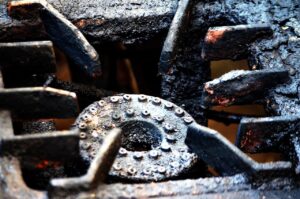A stove is an essential appliance in any kitchen, and when it malfunctions, it can cause a lot of inconvenience. That’s why it’s important to have a systematic approach to diagnosing stove issues. By following a step-by-step process, you can quickly identify the problem and take the necessary steps to fix it. This not only saves you time and money but also ensures the safety of your home and family.
One of the benefits of a systematic approach is that it allows you to identify the root cause of the problem. Instead of just fixing the symptoms, you can address the underlying issue, preventing future breakdowns. Additionally, by following a systematic approach, you can avoid unnecessary repairs or replacements. You can focus on the specific components that are causing the problem, rather than guessing and potentially wasting money on parts that don’t need to be replaced.
Key Takeaways
- Systematic diagnosing of stove issues involves following a step-by-step process to identify and fix problems.
- Common stove issues include power supply problems, burner and igniter issues, gas supply problems, thermostat and temperature sensor malfunctions, and control board and wiring problems.
- Tools and equipment required for diagnosing stove issues include a multimeter, screwdrivers, pliers, and a gas leak detector.
- Safety precautions to take before diagnosing stove issues include turning off the power and gas supply, wearing protective gear, and ensuring proper ventilation.
- The first step in diagnosing stove issues is checking the power supply, followed by inspecting the burners and igniters, examining the gas supply system, checking the thermostat and temperature sensors, and inspecting the control board and wiring.
Understanding the Common Stove Issues
Before diving into the diagnostic process, it’s important to have an understanding of the common stove issues that you may encounter. Some of the most common problems include burners not heating up, uneven heating, gas leaks, and temperature control issues.
Burners not heating up can be caused by a variety of factors, such as a faulty burner element, a broken igniter, or a malfunctioning control switch. Uneven heating is often caused by a faulty burner element or a clogged burner port. Gas leaks can occur due to loose connections or damaged gas lines. Temperature control issues can be caused by a faulty thermostat or temperature sensor.
Tools and Equipment Required for Diagnosing Stove Issues
To effectively diagnose stove issues, you’ll need a few essential tools and equipment. These include a multimeter, screwdrivers (both flathead and Phillips), pliers, wire strippers, and a flashlight. Additionally, it’s helpful to have access to the stove’s user manual, as it contains valuable information about the specific components and their functions.
Having the right tools is crucial for accurate diagnosis. For example, a multimeter allows you to test electrical connections and measure voltage, resistance, and continuity. Screwdrivers are necessary for removing panels and accessing internal components. Pliers are useful for gripping and manipulating wires. Wire strippers ensure clean and precise wire connections. And a flashlight helps you see in dark or hard-to-reach areas.
Safety Precautions to Take Before Diagnosing Stove Issues
Before you begin diagnosing stove issues, it’s important to take certain safety precautions. Working with electrical appliances can be dangerous, so it’s crucial to prioritize safety.
Firstly, make sure to disconnect the stove from the power supply before starting any diagnostic work. This can be done by unplugging the stove or turning off the circuit breaker that supplies power to it. Additionally, it’s important to wear protective gear, such as gloves and safety glasses, to protect yourself from potential hazards.
Furthermore, always exercise caution when working with gas appliances. If you suspect a gas leak, open windows and doors to ventilate the area and avoid using any open flames or electrical devices that could cause a spark. If the gas smell is strong or you’re unsure about your safety, evacuate the premises and call a professional immediately.
Step 1: Checking the Power Supply
The first step in diagnosing stove issues is checking the power supply. This is important because if there is no power reaching the stove, it won’t function properly.
To check the power supply, start by ensuring that the stove is properly plugged into a functioning outlet. If it is plugged in but still not receiving power, use a multimeter to test the outlet for voltage. If there is no voltage, check the circuit breaker or fuse box to see if a breaker has tripped or a fuse has blown. Reset or replace as necessary.
If the power supply is not the issue, move on to the next step of the diagnostic process.
Step 2: Inspecting the Burners and Igniters

The next step is to inspect the burners and igniters. These components are responsible for heating the stove and igniting the gas.
Start by visually inspecting the burners for any signs of damage, such as cracks or discoloration. If any burners are damaged, they will need to be replaced. Additionally, check for any debris or food particles that may be blocking the burner ports. Use a soft brush or toothpick to clean out any obstructions.
Next, inspect the igniters. These are small devices that create a spark to ignite the gas. Check for any visible damage or loose connections. If an igniter is damaged or not functioning properly, it will need to be replaced.
Step 3: Examining the Gas Supply System
After inspecting the burners and igniters, it’s important to examine the gas supply system. This is especially crucial if you suspect a gas leak or if the burners are not igniting properly.
Start by checking the gas valve to ensure it is fully open. If it is partially closed, it can restrict the flow of gas to the burners. Additionally, inspect the gas lines for any signs of damage, such as cracks or leaks. If you detect a gas leak, it’s important to turn off the gas supply immediately and call a professional for assistance.
Step 4: Checking the Thermostat and Temperature Sensors
The next step in diagnosing stove issues is checking the thermostat and temperature sensors. These components are responsible for regulating and maintaining the desired cooking temperature.
Start by setting the stove to a specific temperature and monitoring if it reaches and maintains that temperature. If it does not, it could indicate a problem with the thermostat or temperature sensors.
To check the thermostat, use a multimeter to test for continuity. If there is no continuity, the thermostat is faulty and will need to be replaced.
To check the temperature sensors, use a multimeter to test for resistance. The resistance should change as the temperature changes. If there is no change in resistance, the temperature sensor is faulty and will need to be replaced.
Step 5: Inspecting the Control Board and Wiring
The final step in diagnosing stove issues is inspecting the control board and wiring. The control board is responsible for receiving and processing commands from the user interface, while the wiring connects all the components of the stove.
Start by visually inspecting the control board for any signs of damage, such as burnt or loose connections. If any damage is found, the control board will need to be replaced.
Next, inspect the wiring for any signs of damage or loose connections. Use a multimeter to test for continuity in the wiring. If there is no continuity or if there are any damaged wires, they will need to be repaired or replaced.
Conclusion and Final Tips for Diagnosing Stove Issues
In conclusion, having a systematic approach to diagnosing stove issues is essential for quick and accurate repairs. By following a step-by-step process, you can identify the root cause of the problem and take the necessary steps to fix it.
Some final tips for diagnosing stove issues include keeping a record of any symptoms or error codes that you encounter, as this can help in troubleshooting. Additionally, it’s important to seek professional help if you are unsure about any aspect of the diagnostic process or if you are not comfortable working with electrical or gas appliances.
Remember to always prioritize safety when working with stoves or any other electrical appliances. Take the necessary precautions and seek professional assistance when needed. By following these guidelines, you can effectively diagnose and resolve stove issues, ensuring the safety and functionality of your appliance.
If you’re looking for more information on stove issues and troubleshooting, check out the related article “Common Stove Problems and How to Fix Them” on our blog. This comprehensive guide provides step-by-step instructions on diagnosing and resolving common stove issues. From burner problems to temperature inconsistencies, this article covers it all. Don’t let stove problems ruin your cooking experience – click here to read the full article and become a stove troubleshooting pro!
-How can I ensure safety while diagnosing stove issues using your step-by-step guide?
When diagnosing stove issues, follow essential safety measures for stove to prevent accidents. Turn off the stove, unplug it, and let it cool before inspecting. Use gloves and goggles to handle parts, and keep a fire extinguisher nearby. If in doubt, consult a professional for further assistance.
Table of Contents
- Key Takeaways
- Understanding the Common Stove Issues
- Tools and Equipment Required for Diagnosing Stove Issues
- Safety Precautions to Take Before Diagnosing Stove Issues
- Step 1: Checking the Power Supply
- Step 2: Inspecting the Burners and Igniters
- Step 3: Examining the Gas Supply System
- Step 4: Checking the Thermostat and Temperature Sensors
- Step 5: Inspecting the Control Board and Wiring
- Conclusion and Final Tips for Diagnosing Stove Issues
- -How can I ensure safety while diagnosing stove issues using your step-by-step guide?
- FAQs
- What is systematic diagnosing of stove issues?
- Why is it important to diagnose stove issues systematically?
- What are some common stove issues that can be diagnosed systematically?
- What are the steps involved in systematic diagnosing of stove issues?
- Can systematic diagnosing of stove issues be done by a homeowner?



